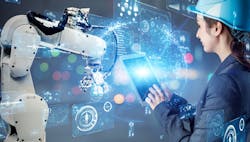What's driving digital technology adoption in industry?
Manufacturing is currently moving out of the time of COVID crisis, and many plants report that they are increasing their digital/automation budgets. Kevin Starr works in the digital service space within ABB for North America and, in particular, the process industries component, and has been involved with every step of service and reliability for the past 34 years. Plant Services Chief Editor Thomas Wilk had the chance to talk with Kevin recently about the digital changes currently taking place in industry, and the extent to which they are being driven by COVID considerations.
Why industrial plant teams need to embrace their creativity to achieve greater success
Why you should automate overall equipment effectiveness data collection
PS: Can you talk about what you’re seeing with challenges getting people back on-site, and/or managing absences due to COVID, and how that’s driving digital technology adoption?
KS: Luckily, we had started the digital transformation prior to COVID and already had the protocols in place, but it’s like anything, people weren’t ready for those. (But then) we were getting requests almost overnight: “Well, you can’t come to site, but I got this thing, this iPad, can we show you (the asset)?” And we said, “Well, sure, you can.”
We started doing what we called “digital rounds” where we could actually harvest the information. You know, the buzzwords of machine learning, artificial intelligence, they’re just philosophies of, “I had a failure, can you look at your data and come up with some model to project or predict that failure in the future?”
We now have analytics that can build off of data models to provide insight into failures so that we can start scheduling (work): “I know you’re going to be down, and the plant doesn’t have anybody on it. We can send in a person that is from your region that is safe and is infection-free, and they can come in and do the work.”
We have seen a shift, a big shift towards embracing the concepts of digital, which is to basically automate or project conventional methods into the digital space so that we can react faster. I mean, they don’t have to wait for the person on-site. Digital never sleeps, and there’s no walls in digital, but there’s still a P in digital, and that P is people. I can’t emphasize that enough. A lot of digital folks have failed when they tried to implement solutions that had no people looking at the information. We’re avoiding that mistake.
PS: What about the types of decisions that plants have been making during the past year regarding automation specifically? It’s a substantive digital investment, and we keep hearing about plants actually no longer planning three years out. They’re actually making the investments now.
KS: We’re seeing marriages of digital opportunities to enhance physical operations, to mitigate the risk of maybe a recurrence of COVID, or some other something. We’re seeing hope, we’re seeing the lights are coming back on, we’re seeing industries adapting.
This article is part of our monthly Big Picture Interview column. Read more interviews from our monthly Big Picture series.
There’s also something else we’re seeing—we’re seeing cyber attacks. You can’t ignore that at your site, if you don’t know when you’ve done your backups, if you don’t do your patch management. Your IT system is great, but your OT system is what keeps the machine running, and if that gets hit, you could be down, and it could cost millions. I’m not trying to scare people, but that’s what we’re hitting is, it’s not something that happens to somebody else now. Nobody wants to see that blue screen, or “Install money here to be able to see your screen.”
The other thing that we’re seeing, is that in the traditional approach, we had subject matter experts on a particular asset class, and they were experts at a facility or a region. (Now) the automation space has grown exponentially, so one person can’t possibly know the entire stack. What we’re seeing is the interconnectivity in the stack of issues that can cause a system to go down are no longer supported by one skillset.
We’re seeing the opportunity to help with digital. You have digital components that can ascertain the health of individual components, but apply analytics to basically expand the sphere of influence of our guys and gals to be able to focus on “there’s something wrong here,” and then be able to pull in the experts from all over the world. We call that the connected engineer program. That’s a big deal.
I think even our customers are like, “If I hire an IT guy, that means I can’t get a control person. If I hire a control person, I can’t get a chemical person.” (We say), “Well, what if I gave you 10% of all the best?” You can’t do that with a person, but with people. Nobody can know everything in the digital space, but you can be alerted to areas to focus. That’s what I’m excited about, is pulling these things together.
This story originally appeared in the July 2021 issue of Plant Services. Subscribe to Plant Services here.

